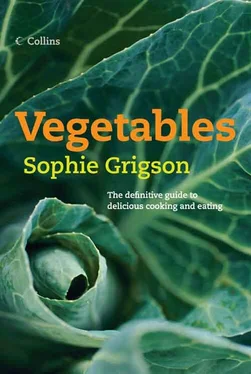1 ...8 9 10 12 13 14 ...22 1 teaspoon vanilla extract
200 ml (7 floz) whipping cream
4 egg yolks
To finish
caster sugar
Bake the kumara in their skins just as if they were potatoes, or peel and boil until tender and drain thoroughly.
Preheat the oven (or reduce the temperature if you’ve baked the kumara) to 140°C/275°F/Gas 1. Weigh out 350g (12oz) of the hot kumara flesh, then mash with the butter and sugar until smooth. Now stir in the vanilla, cream and egg yolks. Divide among 6–8 ramekins. Stand them in a roasting tin and pour enough water into the tin to come about 2 cm (scant 1 in) up the sides of the ramekins. Place in the oven and leave to cook for about 40 minutes until just firm. Take out of the oven and lift the ramekins out of the hot water, then cool, cover and chill in the fridge.
Up to 2 hours before eating, preheat the grill thoroughly. Sprinkle the surface of each baked kumara custard with a thick layer of caster sugar, then place under the grill. Don’t get them too close to the heat – as with any crème brûlée, they need to be close enough for the heat to melt the sugar, but not so close that it burns before it liquefies and caramelises. As the sugar begins to melt, turn the custards every few minutes so that they caramelise fairly evenly. Take out and leave to cool and set. Eat with a little whipped cream.
Make as for the crème brûlées above, but leave out the egg yolks and beat in a little more cream. Don’t cook the mixture – just spoon into bowls and serve as it is.
Will the oca ever make it big in Europe? It ought to. It could…and I for one will be cheering when it does. This small tuber grows well enough here, but its real home is far, far away, up in the chilly heights of the Andes. And in Bolivia, Ecuador and Peru it is rated almost as highly as its compatriot, the potato. I first came across oca in a market north of Quito, the capital of Ecuador. It was the last stop of our holiday, so back came my haul of oca in the suitcase (smuggled in, if you must). We ate some, we grew some. We loved them. Almost end of story.
In fact that would have been the end, if I hadn’t spotted oca for sale here at home a couple of times in the past decade. If you are blessed enough to stumble across a rare basket of oca up for grabs, take them at once. The flavour of the fresh tuber lies somewhere between that of a new potato and a tart green apple, with a mealy, soft texture. Very good and just unusual enough to be interesting, without being weird.
The tart, appley tang comes courtesy of a splash of oxalic acid. If this sounds dismaying, reflect that this same acid gives rhubarb its distinctive sourness, far more astringent than the humble oca. Mind you, there are literally hundreds of varieties of oca grown down the backbone of the Andes and they vary from highly acidic to incredibly mild. The sharper varieties are not eaten fresh, but given a ‘soleado’, or a sunning. Left out in the sunshine for up to two weeks, the acidity dampens right down and starches turn to sugars. The result is an even smaller tuber, but with a startling sweetness closer to a sweet potato than any mouth-puckering stem of pink rhubarb. Dehydrated and frozen oca, known as ‘chaya’, are stashed away for leaner times.
The oca has travelled less than many vegetables, but it has at least dashed across the oceans to New Zealand where it is grown commercially in a small way. Here it is known simply as the New Zealand yam, despite not being a yam at all, or Maori potato, or more interestingly, as ‘uwhikaho’, or ‘uwhi’ for short.
The commonest of oca, the ones that I’ve come across, are relatively small – say about 10cm (4in) long – have a waxy reddish skin and a crinkled form. In fact, they look a little like pink fir apple potatoes. Unlike most vegetables, freshness is not critical. Smooth skinned, plump oca will be gifted with a more distinct note of acidity than those that are beginning to shrivel a little having had time to develop more sweetness. In other words, this is a two-in-one vegetable, which is a rare and delightful gift from Mother Nature. So, as long as they have been stored well, wrinkles are not to be derided. Soft damp patches or worse still, a hint of mould, are not good things on the other hand. However, since you are not likely to come across oca frequently, you can’t really afford to be too choosy. Just throw out any that are beyond saving.
Oca, as you may well have inferred, keep well in the right conditions. The vegetable drawer in the fridge is just fine, but if the sun is shining, you might prefer to spread them out on trays outside (cover with muslin if you have some to hand, to protect from flies) to sweeten up a little. You can even freeze them – not a bad idea if you’ve found a rare clutch of oca for sale. As with any other vegetable, damp is destructive, so keep them dry.
Oca can be eaten raw, especially the sweeter sunned ones, say in a salad, or cut into strips to dip into a chillied tomatoey dip perhaps. I prefer them cooked, exactly as you would a potato. In other words, rinse them, trim off ends, but don’t even attempt to peel. Then boilthem in salted water until tender. They can also be roastedin the oven, coated in a little olive oil to prevent drying out, or steamed, or sautéed. They make heavenly crisps, but perhaps that is something to save for a time when oca have hit the big time and are as widely available here as they are in the highlands of Ecuador.
The parsnip is an honest vegetable. No airs and graces, no pretensions to grandeur, no fancy frills and ribbons. It has a solid sunny nature, the kind that one can rely on time and time again. You can trust a parsnip – trust it to come out well, to cook up nicely, to sit comfortably alongside most winter dishes. Your parsnip doesn’t fade into the background – there’s no doubting its presence – just takes a comfortable stance amongst the other elements on a plate.
I like parsnips a lot, saving them for the colder months of the year, which in the past was the only time when you ever got them. Until recently, no parsnip was worth eating if it hadn’t been touched by a frost or two. Now we get them all year round. That’s modern varieties for you. So maybe I’m being a stick-in-the-mud when I ignore summer parsnips, invariably perfectly shaped and clean as a whistle. Although I know that you can, for instance, make a handsome salad with lightly cooked parsnips, I’m really not that interested when the sun is hot, or even tepid, in the way of so many summer days.
Parsnip is a comfort vegetable, one that rides to the rescue when the courgettes have long since swelled to marrows. Plain buttered parsnip is nice, mashed parsnip good, parsnip crisps excellent and roast parsnips totally irresistible. Frosts may no longer be crucial to the success of the parsnip, but nature has a habit of getting things right. Parsnips are definitely better adapted to cold weather, natural fodder for us humans when the cold weather sets in, but well out of kilter with the warmth of summer.
Most of my adult life, I’ve bought parsnips from either a greengrocer, or from the supermarket, clean as a whistle and ready to cook. I’ve never been disappointed. Until recently. Until I signed up for a weekly veg box and began to receive the occasional helping of dirty parsnips amongst other vegetables. They have been something of a revelation, inducing retrospective disappointment for all those parsnips that have fallen short of these paragons over the years. Yes, I am now convinced that it is worth scrubbing the jacket of earth off those long ivory roots, just for the exquisite flavour that lies underneath. These have been the best parsnips I have ever encountered, putting all others in the shade. That mucky soil coating does indeed keep flavour locked in, just like my mum always said (actually, she was usually talking about potatoes, but the theory is the same). Look out for the muckiest roots you can find next time you visit a winter farmers’ market and leap on them with glee. As long as the dirt is not there to mask stale parsnips pulled far too long before from the ground, I have no doubt that you will notice the improved taste.
Читать дальше












